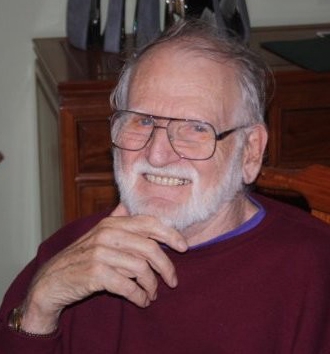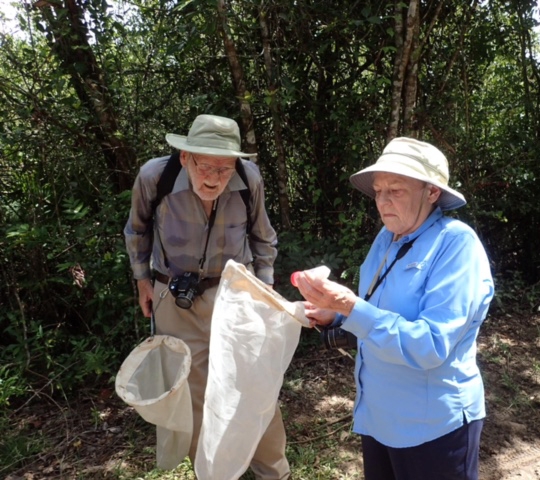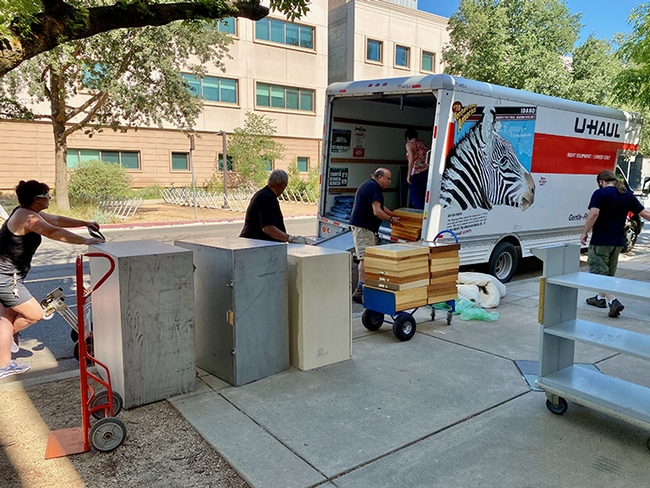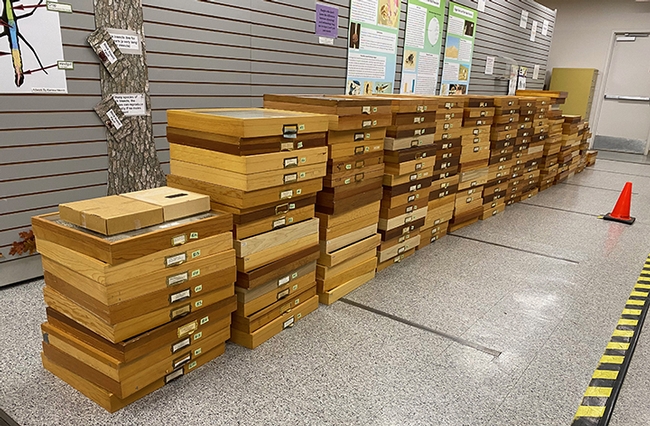- Author: Kathy Keatley Garvey

Spider wasps belong to the family Pompilidae, and are aculeate (stinging) wasps. Most spider wasps (also known as spider-hunting wasps) capture, sting and paralyze their prey. The worldwide family is comprised of some 5,000 described species in six subfamilies.
“A U-Haul was needed to transport the collection from Brookings to Davis last weekend,” said Bohart Museum director and UC Davis distinguished professor Lynn Kimsey.
Wasbauer, who died in the spring, was a global expert on spider wasps and a scientific collaborator with Kimsey. He was a member of the Bohart Museum Society and a strong supporter of the museum.
“The donation consists of a diversity of aculeate wasps but 95 percent are spider wasps (Pompilidae), an estimated 50,000 specimens from all over the world, in 180 drawers, in 13 24-drawer cabinets,” Kimsey said. “This is material he had been accumulating since the 1960s.”
Wasbauer studied entomology and biosystematics at UC Berkeley, where he received his bachelor's degree and doctorate (1958). “Like many entomologists of his generations,” Kimsey said, “Marius was an instructor in preventive medicine in the U.S. 7th Army Medical Service at Fort Sam Houston, Texas.” He joined the California Department of Food and Agriculture (CDFA) as a systematist in September 1958. His CDFA career spanned 34 years.

Wasbauer was a fellow of the California Academy of Sciences; president and secretary of the Pacific Coast Entomological Society; research associate with the U.S. Department of Agriculture's Agricultural Research Service (USDA-ARS), a member of Sigma Xi, the scientific research honor society; a member of the Biosystematists Society; and a research associate at UC Davis.
“He was generous with his time, and worked with many scientists and students around the world,” Kimsey said. “However, aside from his family and wasps, his other greatest love was fishing.”
Marius and his wife, Joanne, longtime supporters of the Bohart Museum, frequently offered annual challenge grants of $5000, matching donations of other donors up to $5000. They hoped to inspire others to give.
The Wasbauers participated in a Bohart Museum Bioblitz to Belize in 2017, a trip led by entomologists David Wyatt, a professor at Sacramento City College, and Fran Keller, now a professor at Folsom Lake College. Keller, who holds a doctorate in entomology from UC Davis, is a Bohart Museum research associate.
A trio of entomologists—Lynn Kimsey and her husband, forensic entomologist Robert Kimsey of the Department of Entomology and Nematology; and Bohart Museum research associate Brennen Dyer—prepared a space in the Bohart for the large donation. They unloaded the truck with Kimsey friends, retired Placer County Sheriff Mike Whitney and his wife, Becky.
The Bohart Museum, which is celebrating its 75th anniversary this year, houses a global collection of nearly eight million insect specimens, plus a live “petting zoo” comprised of Madagascar hissing cockroaches, walking sticks and tarantulas. The Bohart Museum also inclues a year-around gift shop stocked with insect-themed t-shirts, sweatshirts, posters, books, jewelry and insect-collecting equipment.
Temporarily closed due to COVID-19 pandemic precautions, the Bohart is located in Room 1124 of the Academic Surge Building on Crocker Lane.


- Author: Kathy Keatley Garvey

The funds will benefit sustainable pollination research, target colony collapse disorder, and support a postdoctoral researcher, said Walter Leal, professor and chair of the UC Davis Department of Entomology.
“Honey bees are in trouble,” Leal said. “One-third of our nation's food supply depends on bee pollination, but bees are vanishing in massive numbers. This gift will help us to rebuild and revitalize our honey bee program.” Retirements and budget cuts decimated the program during the 1990s.
Häagen-Dazs officials will launch a national campaign on Tuesday, Feb. 19 to create awareness for the plight of the honey bee. Nearly 40 percent of Häagen-Dazs brand ice cream flavors are linked to fruits and nuts pollinated by bees.
As part of the “Häagen-Dazs Loves Honey Bees” campaign, the company created a new flavor of ice cream, Vanilla Honey Bee, available starting Feb. 19; committed a total of $250,000 for bee research to UC Davis and Pennsylvania State University; formed a seven-member scientific advisory board; and launched a Web site, www.helpthehoneybees.com to offer more information on the “unstung heroes.”
Leal said that half of the gift will be used to hire a Häagen-Dazs Postdoctoral Research Fellow in honey bee biology. “We will immediately conduct a high-profile international search and the successful candidate will work at the Laidlaw facility for one year conducting problem-solving research in honey bee biology, health and pollination issues.”
Häagen-Dazs will fund the salary, while the UC Davis Department of Entomology will provide partial matching funds to support other expenses. Leal said the renewal will be contingent on research progress and availability of funds.
Häagen-Dazs brand manager Josh Gellert said that without honey bees, it would be “tough to source and produce” ice cream. By working with UC Davis and Penn State, “we hope to take steps toward finding ways to increase the honey bee population and educate consumers on how they can take part in helping save the honey bees.”
The Vanilla Honey Bee flavor will include a trademarked “Häagen-Dazs Loves Honey Bees” icon, as will all other flavors linked to bee pollination. A portion of the sales will be used to help the honey bees through university research.
Colony collapse disorder (CCD) is a phenomenon characterized by bees unexpectedly abandoning their hives, said apiculturist and Cooperative Extension specialist Eric Mussen of the Laidlaw facility. “Of the 2.24 million colonies in the United States, beekeepers routinely lose 20 to 25 percent annually, but CCD has increased the numbers.”
Mussen said the Apiary Inspectors of America conducted a survey of the nation's registered beekeepers to determine how much of an impact CCD had on their bee colonies from the fall of 2006 to the summer of 2007. “Twenty-three percent of the respondents reported increased losses that appear to be CCD-related,” Mussen said. “Many beekeepers reported losing 30 percent of their colonies. A few lost 60, 80 and 100 percent of their colonies.”
The Harry Laidlaw Jr. Bee Biology Facility team is growing, Leal said. “We just finished conducting interviews Jan. 31 for a bee pollination biologist.” The new hire will join Mussen; bee breeder-geneticist Susan Cobey, Laidlaw facility manager; and native pollinator researcher and emeritus professor Robbin Thorp. Cobey joined the team last May.
The Laidlaw teaching and research facility is considered one of the finest and oldest in the country. Active bee research began on the UC Davis campus in 1925. Today UC Davis serves as a key center of research, teaching, graduate training and extension activities in apiculture and bee biology in the UC system, Leal said. The Chronicle of Higher Education ranks the UC Davis Department of Entomology No. 1 in the nation.
The 8200-square-foot facility, located two miles west of the central campus, is named for UC Davis entomologist Harry Hyde Laidlaw Jr. (1907–2003), recognized as the "father of honey bee genetics” for perfecting artificial bee insemination technology.
Honey bee geneticist Robert Page, former chair of the UC Davis Department of Entomology and now the founding director of the School of Life Sciences, Arizona State University, worked closely with Laidlaw. “All of us who have made our careers studying the genetics of honey bees stand on the shoulders of Harry Laidlaw,” he said. “Harry was totally dedicated to honey bee breeding and apiculture from the time he opened his first hive of bees when he was 5 years old, until he died at 96.”
The newly formed Häagen-Dazs Ice Cream Bee Board includes three UC Davis scientists: Mussen, Cobey and Michael Parrella, professor of entomology and associate dean, College of Agricultural and Environmental Sciences. The board will advise company officials on scientific issues; announce new research findings; and educate the public on ways to help save the honey bee.
Mussen noted that honey bees are responsible for pollinating more than 100 U. S. crops, including fruits, vegetables, nuts and seeds. California produces 99 percent of all the almonds grown in the United States. Growers need two hives per acre to pollinate the state's 700,000 acres of almonds, valued at more than $2 billion, Mussen said.
Said Parrella: “The Häagen-Dazs brand and UC Davis have a shared goal of preserving our local natural ingredients in a sustainable future, and their donation to the Laidlaw facility will help us reach our goals through advances in research and community awareness programs.”
California State Beekeepers' Association president Jackie Park-Burris of Palo Cedro, Shasta County, described the Häagen-Dazs gift as “just awesome.”
“We're so happy that industry is recognizing the issues that the bees and beekeepers face,” Park-Burris said. “Last month at our national beekeeping conference, we gave a standing ovation to Häagen-Dazs for stepping forward to help us. This is an example of what a business can do, and maybe more businesses will get involved.”
“It's exciting that the honey bee program at UC Davis is being rebuilt and revitalized,” Park-Burris said.
Dori Bailey, director of consumer communications for Häagen-Dazs, received the standing ovation at a UC Davis dinner on Jan. 10 when she outlined her company's support for honey bees to the American Honey Producers' Association, American Beekeeping Federation, American Association of Professional Apiculturists and the Apiary Inspectors of America.
“It was a great presentation,” said Park-Burris, who noted that the beekeepers were the first (outside the company) to sample the new Vanilla Honey Bee ice cream. “You could really taste the honey. It's excellent.”
Beekeepers say the general public can help save the honey bees by planting a bee friendly garden; educate others about the honey bee decline; buy U.S. honey; and support research to help preserve the nation's food supply.



